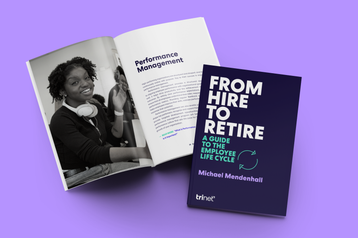Generational Differences in the Workplace: Boomers, Gen X, Gen Y, and Gen Z Explained

Table of contents
- 1.What are the different generations in today’s workforce?
- 2.What generation comes after Gen Z?
- 3.What percentage of today’s workforce does each generation account for?
- 4.How do you motivate different generations in the workplace?
- 5.How to motivate baby boomers
- 6.How to motivate Generation X
- 7.How to motivate Gen Y (a.k.a. Millennials)
- 8.How to motivate Gen Z
- 9.What else should HR managers know about generations in the workplace?
While generational differences may seem small, they have a big impact in the workplace.
Typically, work is one place where all generations come together. From boomers to Gen Z, people of all ages collaborate within teams and on projects. Navigating generational differences in the workplace can be challenging for managers trying to increase employee motivation, morale and productivity. This is because each generation tends to want something different from the workplace. It’s your job as an HR pro to empower managers to develop strategies that engage employees of all different ages to keep them motivated and happy.
Understanding the generational diversity between baby boomers, Gen X, Gen Y (a.k.a. Millennials), Gen Z and beyond is a great start. Knowledge is power in the effort to harness their collective strengths and understand how to effectively communicate, manage and lead them. The more you know about each generation, the better able you’ll be to navigate issues and sidestep potential conflicts.
Let’s explore some of the nuances and distinctions among different generations in today’s workforce.
What are the different generations in today’s workforce?
Today’s workforce is made up of four distinct generations.
- Baby boomers are the eldest, born between the years 1946 and 1964.
- Generation X follows, and they were born between 1965 and 1980.
- Next comes Generation Y (more commonly known as Millennials), born between roughly 1981 and 1994.
- The youngest generation in today’s workforce is Gen Z, meaning Generation Z, who were born between 1995 and 2009.
What generation comes after Gen Z?
You might be wondering who will come after Gen Z in future workforces. Next up is Generation Alpha, currently considered to be those born around 2010 and later. The eldest of that group are still teens, but it won’t be long until they’re looking for their 1st jobs.
As you can imagine, there exist vast differences in the workplace preferences and communication styles between people born in the 1960s and those born in the 2000s.
Furthermore, anyone, from youngest to older workers, might be concerned about generational stereotypes or covert age discrimination if they feel misunderstood.
What percentage of today’s workforce does each generation account for?
In 2016, Millennials became the largest generation in the workforce, according to Pew Research. As of 2017, there were 56 million Millennials in the workforce followed by 53 million Gen Xers and 41 million baby boomers. In fact, as of 2018, 29 percent of boomers were actively looking for work. This is an anomaly that hasn’t been seen since the 1970s. As for the rest of the younger generations, there were nine million Gen Zers in the workforce. And, surprisingly, three million from the “Silent Generation” (born before boomers) worked as well.
This means that Millennials make up more than 1/3 of the U.S. workforce. Gen X takes up 1/3 of the workforce itself, while boomers represent 1/4 and Gen Z, about five percent.
How do you motivate different generations in the workplace?
As a supervisor or HR manager, it’s important to understand the dynamics of a multigenerational workforce. This includes what drives both your elder and younger employees and how you might best motivate them all. Consider the traits, experiences and preferences that factor into motivating baby boomers vs. Millennials vs. Gen Z vs. Gen X, Gen Y and beyond.
How to motivate baby boomers
Many in the baby boomer generation equate work to self-worth and long-term financial and job security. Many were born into families who endured the profound upheavals of the Great Depression and/or World War II. Perhaps more than other generations, boomers are motivated by title, prestige, retirement benefits and other traditional perks. Getting things accomplished at work and having those accomplishments recognized and rewarded can go a long way in managing a baby-boomer employee.
Boomers are also goal oriented. As a whole, they tend to be OK with minimal feedback, assuming that everything is fine unless they’re told otherwise. Many baby boomers can be motivated by milestones like promotions and upgrades to prestigious roles and job titles. They tend to function best in traditional, hierarchical environments, and some may struggle in workplaces with more flexible approaches.
How to motivate Generation X
Many who grew up in the Gen X years had a lot of alone time because both of their parents worked. This meant that they got themselves home from school, made their own afterschool snacks and entertained themselves. Because of this, Gen Xers are happy to work independently with minimal supervision. They’re often credited with introducing the idea of work-life balance into the workforce. Many of them saw their parents dedicate themselves to the idea of working hard and enjoying retirement later only to face an economic downturn in the 1980s that undermined the financial stability they’d built. Understandably, they have a healthy skepticism of working so much that they miss out on their lives and the lives of their children.
This means they gravitate toward perks like flexible schedules and telecommuting, which are becoming more popular due to the advancement of technology. Gen Xers tend to be very independent. They generally prefer to make their own choices regarding how their projects are completed and how they manage their workdays. So consider letting them innovate their own ways of doing things or select tasks on a daily or weekly basis. Allowing them reasonable freedom and flexibility can go far toward improving their morale and productivity.
How to motivate Gen Y (a.k.a. Millennials)
Comparing Gen X vs. Millennials doesn’t require much of a stretch. Although Millennials, either correctly or incorrectly, are often characterized as job hoppers. This is because they often believe that better pay and benefits can be found somewhere else. They aren’t the first generation to believe that if you want a pay raise or promotion you’ll have to go find it elsewhere. But they do seem to fully embrace the concept.
The good news is that pay and benefits aren’t the only things that motivate Millennials. Like their Gen X predecessors, Millennials tend to love flexibility, options and professional-development opportunities. Of course, it’s not only Millennials who will switch jobs if they feel like their careers are stagnating. Any member of any generation may start looking for a new job if they feel like they’re not getting anywhere in their current job.
HR managers can help retain Millennial talent by providing plenty of mentorship and career-development opportunities for professional growth and advancement.
How to motivate Gen Z
Gen Z can be a lot like their Millennial predecessors, but there are a few places where they stand out. First, they want fulfillment and a sense of purpose from their work. In other words, they want work that matters. They expect sincere corporate social responsibility, and they expect those initiatives to be applied internally as well. Gen Z may be the most diverse generation yet. And naturally, diversity and inclusion efforts matter to the age group perceiving itself as most impacted by them.
In terms of Gen Y or Gen X vs. Gen Z, Gen Z saw their parents suffer economic hardship and job loss surrounding the Great Recession of 2008. So they can be particularly motivated by pay and traditional financial incentives like bonuses and other forms of variable compensation. Perks such as a 401(k) match, retirement benefits, healthcare coverage, student loan repayment and tuition reimbursement are also important to Generation Z.
What else should HR managers know about generations in the workplace?
Give credit where due regarding the virtues of tech savviness. It’s important to recognize that Millennials, Gen Z and the later years of Gen X grew up with vast advancements in technology. These groups are digital natives, which means they tend to have an automatic understanding of it. They typically take less time getting up to speed with new technologies. And they can often suggest technological solutions in the workplace to increase productivity and output. As an employer or manager, listening to your employees and implementing their most helpful ideas can go a long way toward building trust, retaining your talent and improving your bottom line.
By understanding multiple generations and what motivates them, you can avoid making age-based assumptions or contributing to stereotypes. You can replace the proverbial “generational gap” with a cohesive workforce that is productive, motivated, and adept at problem solving. You may even find successful ideas and technologies that were once used by older generations that can be deployed once again to streamline processes and improve productivity.
Business has its challenges. And we’ve got solutions. Count on TriNet throughout the day for tips, tools, and support along the HR and business management journey.

TriNet Team
Table of contents
- 1.What are the different generations in today’s workforce?
- 2.What generation comes after Gen Z?
- 3.What percentage of today’s workforce does each generation account for?
- 4.How do you motivate different generations in the workplace?
- 5.How to motivate baby boomers
- 6.How to motivate Generation X
- 7.How to motivate Gen Y (a.k.a. Millennials)
- 8.How to motivate Gen Z
- 9.What else should HR managers know about generations in the workplace?
Trending now
- Compliance





